 History of
medieval Colchester
History of
medieval Colchester History of
medieval Colchester
History of
medieval Colchester
| Origins and early growth |
Few, if any, of England's towns can lay claim to the longevity that Colchester can; certainly none in East Anglia. The site was inhabited by the seventh century B.C. and was in the first century B.C. the economic and military centre of one of the various kingdoms of which ancient Britain was composed. This settlement lay on the ridge above, and the slope stretching down to, the southern bank of the Colne River, just a few miles northwest of where the Colne emptied into the North Sea. This capital was an early target of the Roman invaders (A.D. 43) and within a few years they had converted it into Roman Britain's first colony of retired legionaries and the administrative centre of a canton; a solid wall was built to protect a rectangular-shaped area beside the river. The wall and the Roman streets influenced the layout of medieval Colchester.
After the Romans left Britain, the Saxons settled within the old walls (an atypical case of Saxon habitation of a Roman town), but we have no mention of the town until 917, when it is evident that it was being contested between Danes and Anglo-Saxons. Its walls continued to make it an important regional stronghold and, by the time of Domesday, it was a borough of some significance, with the status of a hundred, its own court, a mint (an indication of the importance the king placed on a town), and several churches. The Colchester entry in Domesday is more detailed than those for most East Anglian towns, and the term civitas (city – although here possibly implying "district") is applied alongside that of borough. There were 276 burgesses in 1086 under the direct lordship of the king, and about 450 households in all within the borough's boundaries.
The Normans recognized Colchester's strategic value and, perhaps within a decade of the Conquest, began constructing a castle which included the largest keep in Europe, built atop the foundations of the principal Roman temple. The king included control of this fortress among various properties and authorities in Essex given to his steward, Eudo, as reward for his long support; Eudo may have been in charge of its construction (at least, later generations thought so). Henry I went so far as to turn over his lordship of Colchester to Eudo in 1101, although it reverted to the king after Eudo's death (1120). Eudo in 1096 founded St. John's Abbey just south of the walled town; the abbey held an annual fair for a few days in June. A little to the east of the Benedictine abbey site, again just outside the walls, was a church whose dedication – to St. Botolph – indicates it of Anglo-Saxon origin. A few years after, and probably in response to, the foundation of the abbey, this church became an Augustinian priory. Still further east, Eudo founded a leper hospital dedicated to St. Mary Magdalene; Richard I granted that the hospital have the right to hold a fair in July.
The twelfth century saw the town expanding beyond the walls, particularly into a suburb to the south, around the abbey and priory. A thriving, if somewhat detached, suburb also developed to the south-east around the town's harbour at New Hythe; this was successor to an earlier haven at Old Hythe further south along the river, which was revived in the 1340s, perhaps being about as far along the river as sea-going ships could navigate. Lesser suburbs arose around the bridges across the Colne to the north and east of the walled area. This was the shape of medieval Colchester. Nonetheless, we should hardly think of the town as crowded by modern standards; its population in the Late Middle Ages probably fluctuated between 3,000 and 8,000.
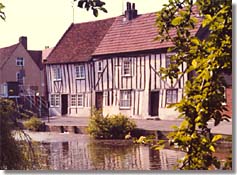
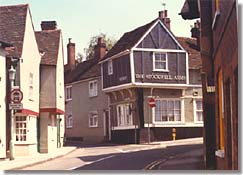
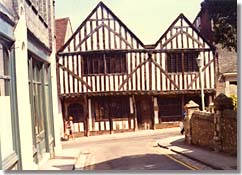
Colchester domestic architecture
There remain a few examples of 15th / 16th century architectural styles,
such as those in the Stockwell Street area and [top] near North Bridge;
they leave a faint impression of how Colchester might have looked
at the close of the Middle Ages.
photos © S. Alsford
| Development of local government |
Colchester's first known royal charter was received in 1189 and gave the borough the foundations of self-government. The similarity between the terms of this and the 1133 charter of London liberties has led to speculation that the 1189 grant may have been only a confirmation, or modification of an earlier one, perhaps from just before the period (1178-94) when burgess representatives seem to have been answering for the borough farm; however, we should not read too much into this. Through the 1189 charter the king permitted the townsmen the right to choose, from among their number, two bailiffs to head the administration of local justice, which included authority over matters relating to commercial and real estate transactions; he recognized the pre-eminence of local customs within the borough bounds (or "liberty"), while exempting the borough from certain external authorities or obligations. Freedom from paying tolls on merchandise in other English localities was granted, and the holding of any market (other than the borough's own) within the liberty was prohibited. Fishing rights along a particular stretch of the Colne (regardless of who owned the land along the banks) were confirmed, as was the right to hunt fox, hare or polecat within the liberty.
Archaeology has provided evidence that the seat of local government, the moothall, may have been built around that time. Administration focused around the sessions of the town court held there. The official "hundred court" was held on Mondays – usually fortnightly, but sometimes weekly – to deal with normal legal business; additional court sessions were introduced as the fourteenth century wore on, on any weekday necessary, to take care of extra business, pleas introduced by non-citizens, and cases whose handling required speed. In addition, 3 lawhundred sessions were held annually, at which all those owning land in the town (whether burgesses or not) were supposed to attend; here were made the public presentments of breaches of local custom, ordinances and national statutes. Four administrative wards cross-cut the geographical entity that was Colchester, comprising the walled town, its suburbs and neighbouring villages (see under Economy).
Colchester underwent the growth pains typical of most medieval towns, in terms of contests for jurisdiction with neighbouring authorities. The bailiffs had to share jurisdiction in the rural parts of the liberty with manorial lords, who would have preferred complete independence for their estates. As early as Domesday the town was complaining that some of the properties which had formerly contributed to paying the customary dues owed by town to king were evading that obligation. In Colchester's case the main rivals were the Abbot of St. John's, a powerful and wealthy ecclesiastic, and John FitzWalter lord of Lexden manor together with his steward (and tenant of Langenhoe manor) Lionel de Bradenham. The latter lost their contest – which focused on rights relating to the river – after resorting to illegal methods, including intimidation of individual townsmen and a 13-week siege of the town (1350), which led to the king imposing crushingly heavy fines on them.
The abbey was the single most important landlord of the properties within the borough liberty, although his lands were mainly in the villages; the abbots pursued a policy of improving their estates, which often involved enclosing parcels of land. The not surprising result was that the abbot and the town would come into conflict over jurisdiction regarding those areas. The townsmen were quick to challenge any encroachment on what they considered their rights of passage, pasturage, hunting or fishing within the liberty. Furthermore, up to mid-fourteenth century, many of the men who led the town government as bailiffs were themselves prominent landholders. Much space in the medieval borough records is taken up with documents pertaining to the legal battles. In 1254, for example, a settlement of disputes between the parties led to the abbot acknowledging the right of the burgesses to hunt hare, fox and cat in parts of Greenstead and West Donyland (hamlets within the liberty), with catches tolerated even in the abbot's own hunting warren so long as the townsmen called back their dogs once the prey was caught, and so long as reparations were made for any damage to crops. In return the borough recognized the abbey's warren in West Donyland, granted the monks and their tenants freedom from tolls on goods for personal use (goods for purposes of resale, however, were still to be subject to tolls), and agreed to the abbey having pillories and cucking-stools in West Donyland and Greenstead.
Agreements such as this tended to fall by the wayside when new disputes arose. A series of complaints made by the townsmen in the 1280s before the lawhundred or to the king indicate the kinds of disputes that continued to plague town-abbey relations; charges included that the abbot:
The abbot's defence was, essentially, that the abbey and its properties were not, administratively, within the borough liberty. Inquisitions into the disputes for the most part came to the opposite opinion. In the second half of the century, the disputes between town and abbey quietened, but flared up again at the close of the century – with a particularly assertive abbot having been accused, in 1398, of sending armed riders into the town to terrorize the citizens – and continued in the fifteenth, when the abbot's name again features prominently in lawhundred presentments.
A royal charter of 1447 was acquired by the townsmen in order to try to overcome local disputes. The charter included the specification of which hamlets were part of the liberty, and additional specification (beyond the terms of earlier charters) of the types of cases that fell within the jurisdiction of the borough court.
Constitutional reform, to place checks on the government of the bailiffs and to introduce a system in which there was greater accountability for expanding and more diversified borough revenues, took place in Colchester in 1372; whether it was provoked by specific abuses of power or physical expressions of popular discontent, as in some other towns (e.g. Ipswich), is unknown. The reforms laid out somewhat involved procedures for electing bailiffs, and introduced financial officers and a council chosen from the "wisest" townsmen to work with the bailiffs in governmental decision-making. Urban administration was becoming a more formalized affair, requiring a larger number of officials, with more specialized roles. In the years immediately following the reform, Colchester's records paint a picture of a revitalized administration undertaking a variety of actions improving the borough fabric and expressing civic pride, including a perambulation of the liberty (a symbolic assertion of the extent of geographical jurisdiction).
By contrast, subsequent constitutional adjustments, in the fifteenth century and later, were a response to the growing complexity of administrative responsibilities placed on towns by the king, combined with the social tensions resulting in part from a downturn in the borough economy. The outcome was an ultimately successful effort by the wealthier townsmen to protect their group interests by at first formalizing their domination of government and later monopolizing it. The royal charter of 1447 strengthened ballival authority by adding to it powers formerly exercised by royal officers – the Clerk of the Market and the Justices of the Peace, while that of 1462 incorporated the borough and redefined its governmental structure.
| Buildings and fortifications |
Apart from a few medieval cellars, little of the medieval borough remains today except for the fortifications and ecclesiastical structures. Holy Trinity church still has its Saxon tower (ca. 1000). The remains of St. Botolph's priory, although partial and ruinous, are nonetheless sufficient to give a strong impression of the size and solidity of the church as it would have been in the twelfth century. Of St. John's Abbey only the fifteenth century gatehouse remains, although this too is an impressive structure reflecting the wealth of the house.
All that still stands of the medieval castle is its keep (which is a broader version of the Norman keep in the Tower of London, although its upper floors were torn down in the post-medieval period), a portion of the earthern ramparts that surrounded it, and foundations of a second, minor building. The castle was probably begun in the 1070s, perhaps as much a response to threats of Danish or Flemish invasion at that time as an element in the Conqueror's attempt to control his new realm (Colchester apparently having offered him no trouble, in contrast to Norwich). The castle was always held by the king, although when it underwent its only siege (1216) it was the supporters of the rebellious barons who surrendered it to King John's men. Colchester had managed to avoid involvement in the civil war between Stephen and Matilda, and again in the baronial wars of mid-thirteenth century. After the end of the those wars, the main role played by the castle during the Middle Ages was as one of the county prisons and the site of some trials of prisoners (Colchester records describe a trial by combat there in 1375); Chelmsford, as a more central location in Essex, however, was chosen as the seat of the shire court. By the end of the Middle Ages the castle was starting to decay from lack of use and maintenance.
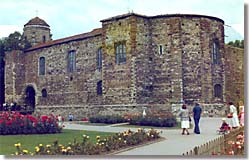
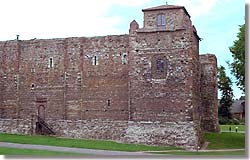
Two views of Colchester castle
[left] western end, with entrance constructed in the 12th century
(the small dome being a post-medieval addition)
[right] eastern end
photos © S. Alsford
Parts of the town walls and the ruins of one of its gates also survive today, having served the Romans, the Anglo-Saxons and the medieval townsmen. It was the walls that the townsmen chose to symbolize them on the borough seal; a similar expression of attitudes is reflected in medieval paintings of towns, which tend to overemphasize the walls and towers. However, that did not stop the townsmen from plundering them for building materials, or for building houses right up against the wall. Efforts were made to keep the walls in good condition, beginning at least as early as King Edward the Elder's repair efforts after Colchester had been besieged and recaptured from the Danes in 917. In 1382 local records talk of ongoing repair work on the walls, and it was at this time that Richard II granted Colchester the first of three exemptions from the costs of sending representatives to parliament, in view of the expense of wall maintenance. Part of the costs involved adding bastions. Possibly the work on the walls was prompted by the Peasants' Revolt – one of whose leaders, John Ball, had lived in Colcester – during which a mob had disrupted the government of the town, threatened to destroy town records, and actually followed through on a similar threat against St. John's Abbey.
| Economy |
Archaeology has found evidence that Colchester's inhabitants were already engaged in trade with the continent in the time of the ancient Britons; they were importing pottery, as well as imitating Belgic pottery in kilns in the vicinity of Colchester. The town's position near the coast, giving access across the North Sea to the markets in the Low Countries and the Baltic, and at the mouth of a major river system leading into East Anglia, was an advantage, as similar circumstances were for other East Anglian towns such as Lynn, Yarmouth and Ipswich. Colchester had an added advantage of proximity to London, as well as a good connection thereto via the old Roman roads system, although this later proved disadvantageous when (in the fifteenth century) the export of products of Colchester's cloth-finishing industry fell under the influence of the Hanse merchants based at the London Steelyard. In the opposite direction, a road ran to Ipswich.
Yet despite its long-standing international trade and its road connections to other English towns, Colchester was not as important a mercantile centre as towns such as Norwich, Lynn or Ipswich; the market for its agricultural produce or for the products of most local industries was primarily regional. The Colne provided it with a minor fishery – notably sole and the oysters for which Colchester was famous; a related annual fair was held at the beginning of the oyster season (October) and probably dates back to at least the twelfth century, although its first formal recognition was in a royal charter of 1319. None of the fairs held by the various religious houses seems to have been significant enough to attract foreign merchants. On the other hand, the town flourished sufficiently to encourage Jewish settlement in the reign of Henry II – the royal castle there being another attraction; this community had its own bailiff by 1220 but declined in later decades, so that by 1290 only a handful of relatively poor Jewish householders remained.
The pursuits of Colchester's residents were a combination of agrarian, fishing, mercantile and industrial, in a more even balance than other East Anglian towns of comparable size. Many burgesses were involved to some extent – whether personally or through employees – in agricultural activities as one of the means of earning their livelihood (e.g. crops might be grown to supply brewing retail). The area south of the walls in particular held many of the townsmen's pastures and fields; the type of soil favoured the cultivation of rye. The boundaries of the liberty of Colchester (i.e. the hundred) in fact extended well beyond the Roman walls to encompass, in addition to the immediate suburbs, four nearby villages: Lexden (west of the town), Greenstead (east), Mile End (north), and Berechurch (south), although these were also affiliated in some regards with manorial estates. At the time of Domesday, about 120 residents seem to have owned houses but no land, whereas the majority held tracts of land varying from one to ten acres each, suggesting an interest, although not an exclusive one, in farming. In the national taxations of 1296 and 1301 we see almost exactly the same proportion of townsmen (69%) on both occasions owning livestock; some owned only one or two animals, whereas others had large flocks or herds. Agricultural pursuits were, not surprisingly, most prevalent in the villages within Colchester's bounds, whereas the residents of the walled area were more engaged in commercial activities.
In the thirteenth century Colchester acquired a small role in cloth-making, and this industry gradually became more important to the town as the Middle Ages wore on, helped by the immigration of Flemings in the second half of the fourteenth century. Colchester merchants had a modest involvement in the wool trade, while local cloth, such as the russet for which the town had some fame, found markets across England and abroad. There were already a few fullers operating in the town in the twelfth century and the area around Colchester became a focus for the building of mills either partially or wholly used for fulling. Eight mills are known to have operated within the bounds of Colchester itself during the fourteenth century, although not all continuously. As the cloth-finishing industry became more important, mills switched from grinding grain to fulling cloth; the mill at New Hythe, for example, was made available by the town authorities to fullers, for a per-cloth fee.
In the thirteenth and early fourteenth centuries cloth-making was hardly a major industry in Colchester; leather-based industries – such as tanning and shoemaking – seem to have been equally important (at least in fulfilling the needs of local markets), and locally-made pottery found a regional market. While the leather industry declined, however, from the second half of the fourteenth to the early fifteenth century Colchester cloth-makers and merchants, like those of other east coast towns, benefited from the expansion of markets in the Baltic and Gascony; Colchester russet even found a market in Mediterranean countries, although via the London trade. But as the fifteenth century progressed, the cloth industry too went into a decline, as war and depopulation damaged the Baltic and Gascon markets. It came more under the control of, on the one hand, craft gilds whose role in assuring quality standards also meant restricting participation in the industry and, on the other hand, of wealthier townsmen who could afford to be involved in all aspects of clothmaking (purchase of wool, operation of mills, employment of cloth-finishers, exporting of cloth).
There were two wool and cloth fairs held in Colchester each year, in June and July; by the second half of the fourteenth century these had outgrown their original sites. One citizen's home hosted a privately-run wool market at the beginning of the 1370s, but the borough authorities soon took this over, settling it in the newly spruced-up cellar under the moothall (1373/74). They quickly followed this up by taking control over the fairs and accommodating elements of these too in the moothall cellar and the nearby High Street (the rents for stalls there helping with the borough budget); trading in private houses was prohibited.
Wine was the leading item among goods imported by Colchester's merchants, and grain prominent among their exports, although many simply dealt in whatever goods were available or in demand at any given point. However, generally Colchester was by no means as important a centre for import/export as Ipswich, to which Colchester's harbour was purely a subsidiary within the national system of customs collection. While Colchester's High Street market remained a regional distribution mechanism, wholesaling increasingly focused around the New Hythe suburb; Edward IV's charter to the borough restricted the buying and selling of imported goods to New Hythe, where ships landed goods. Yet only a handful of townsmen owned ships large enough for crossing the sea and mooring space at the Hythe was limited. Much of the international trade conducted through Colchester was in the hands of outside merchants. During the Middle Ages, Colchester never developed the degree of wealth that some of the younger, and often smaller, towns in East Anglia achieved.
| Information sources |
The following is a small selection of published sources of information about medieval Colchester. For additional secondary sources as well as primary sources, see the bibliography to The Men Behind the Masque.
Benham, W.G., ed. The Red Paper Book of Colchester. Colchester, 1902.
Benham, W.G., ed. The Oath Book or Red Parchment Book of Colchester. Colchester, 1907.
Britnell, R.H. Growth and Decline in Colchester, 1300-1525. Cambridge, 1986.
Britnell, R.H. "Colchester Courts and Court Records, 1310-1525." Essex Archaeology and History, vol.17 (1986), 133-40.
Britnell, R.H. "Bailiffs and burgesses in Colchester 1400-1525." Essex Archaeology and History, vol.21 (1990), 103-09.
Martin, G.H. The Story of Colchester: from Roman Times to the Present Day. Colchester, 1959.
Morant, Philip. The History and Antiquities of Colchester. London, 1768.
Powell, W.R. "Lionel de Bradenham and his siege of Colchester in 1350." Essex Archaeology and History, vol.22 (1991), 67-75.
Rodwell, W. Historic Churches: A Wasting Asset. Council for British Archaeology Research Report, no.19 (1977).